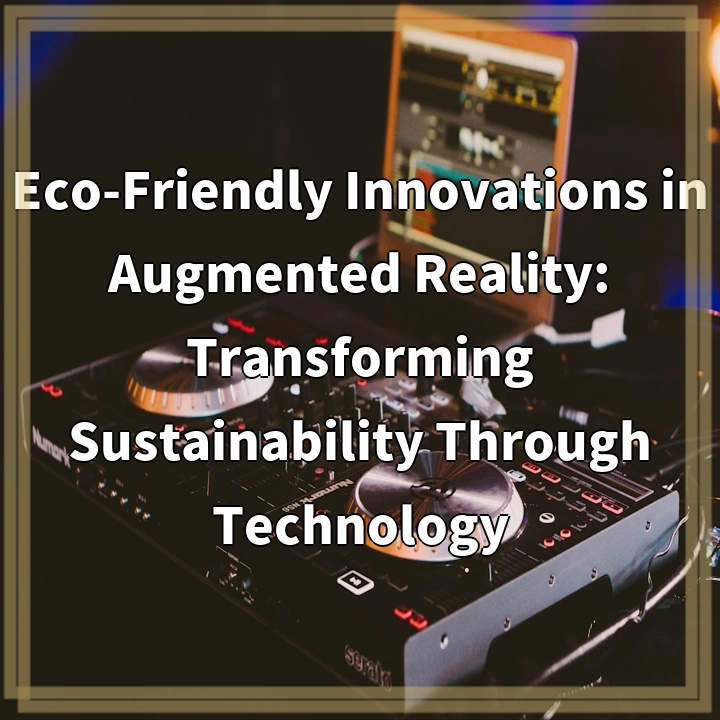
What it is:
Eco-friendly innovations in augmented reality (AR) refer to the incorporation of sustainable practices and technologies within the realm of AR applications. Augmented reality is an interactive technology that overlays digital information—such as images, sounds, and text—onto the real world, enhancing the way we perceive our surroundings. By integrating eco-friendly innovations, AR can play a pivotal role in addressing environmental issues, promoting sustainable habits, and raising awareness about ecological challenges.
Examples of Eco-Friendly AR Innovations
Some key examples of eco-friendly innovations in augmented reality include apps that visualize the impact of climate change in real-time, tools for sustainable urban planning, and educational platforms that inform users about biodiversity and conservation efforts. By providing immersive experiences, these innovations help users understand the importance of sustainability and encourage them to adopt greener practices in their daily lives.
Real-World Problems
1. Environmental Awareness
Despite the increasing awareness of environmental issues, many individuals still lack a deep understanding of the complexities involved. AR can bridge this gap by showcasing real-world scenarios and the potential environmental impacts of actions or policies. However, without the widespread adoption of AR technology, many people may remain unaware of the pressing problems facing our planet.
2. Resource Management
Proper resource management is critical for maintaining sustainability, yet industries often struggle to visualize the impact of their operations. Eco-friendly AR applications can guide companies in optimizing their resource usage and minimizing waste, but resistance to adopting new technologies can hinder progress.
3. Climate Change Mitigation
Climate change is one of the most urgent global challenges, and while AR can provide innovative solutions for visualization and education, it will not solve the problem on its own. The real-world implementation of these technologies requires significant investment, collaboration, and policy support to create meaningful change.
4. Digital Divide
The effectiveness of eco-friendly augmented reality is limited by the digital divide, which highlights disparities in access to technology. Rural or economically disadvantaged communities may not have the resources to engage with AR innovations, leading to unequal educational opportunities and information access. To address environmental problems equitably, it’s crucial to bridge this gap.
5. Waste from Technological Advancements
While AR holds promise for eco-innovations, the technology itself can contribute to electronic waste, especially as devices become obsolete. Developing sustainable practices in the production and disposal of AR technologies is essential for ensuring that these innovations remain genuinely eco-friendly.

Solutions to Eco-Friendly Innovations in Augmented Reality
To effectively harness the potential of eco-friendly innovations in augmented reality, it is essential to implement various solutions that address the real-world problems associated with its adoption and usage. Below are some key strategies to promote sustainability through AR technology.
1. Enhance Environmental Awareness Through Education
Utilize augmented reality as an educational tool to foster environmental awareness among users. By creating immersive experiences that visualize the impacts of climate change, habitat destruction, and resource depletion, AR can help individuals understand the urgency of environmental issues. Collaborations with educational institutions and environmental organizations can amplify this impact.
2. Optimize Resource Management with AR Tools
Encourage industries to adopt AR technologies that facilitate efficient resource management. By providing real-time data visualization and analytics, AR applications can assist companies in minimizing waste and improving operational sustainability. Offering incentives for early adopters can further encourage widespread integration into business practices.
3. Invest in Climate Change Mitigation Strategies
Support research and development initiatives that focus on creating AR solutions aimed at climate change mitigation. This includes developing applications that model future scenarios and guide policymakers in assessing the environmental impact of various actions. Public and private sector partnerships can drive investment and foster innovation in this arena.
4. Bridging the Digital Divide
Addressing the digital divide is crucial for the equitable implementation of eco-friendly AR solutions. Initiatives to increase access to technology in underserved communities—including providing resources, internet connectivity, and training—are vital for ensuring that everyone can benefit from AR innovations aimed at sustainability.
5. Promote Sustainable Practices for AR Technology
Encourage manufacturers and developers of AR technologies to adopt sustainable practices, such as utilizing eco-friendly materials and implementing recycling programs for electronic products. By prioritizing sustainability throughout the lifecycle of AR devices, the negative impact of electronic waste can be mitigated, ensuring that innovations remain environmentally responsible.















